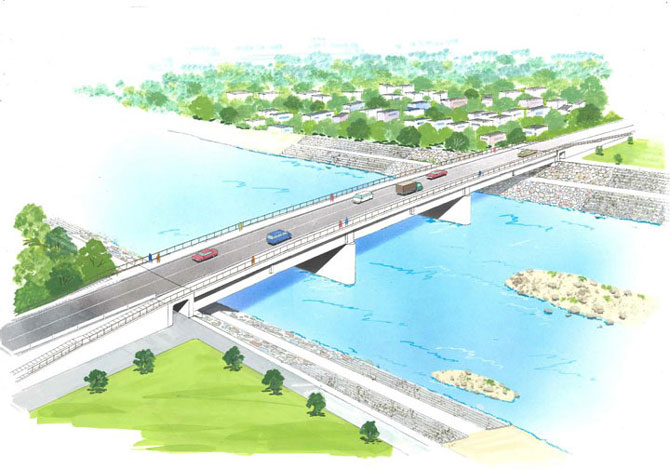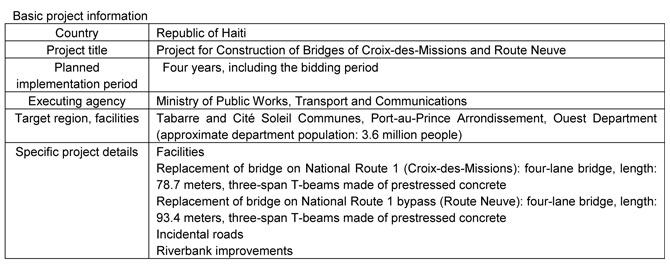[Japan International Cooperation Agency] [Wednesday, Sep 9, 2015]
Signing of Japanese ODA Loan Agreement with the African Development Bank Group: Accelerating Economic Growth Led by the Private Sector
On September 8, the Japan International Cooperation Agency (JICA) signed a loan agreement with the African Development Bank Group (AfDB) to provide loans of up to 35.88 billion yen for the Private Sector Assistance Loan under the Joint Initiative titled EPSA for Africa (VI).
This is the sixth Japanese ODA loan to the AfDB’s Private Sector Financing Operations [1] as a part of Enhanced Private Sector Assistance for Africa (EPSA for Africa). With the objective of promoting private sector led economic growth and poverty reduction in Africa, JICA will provide the loans to support project financing for infrastructure, agriculture and private enterprises in AfDB member countries [2].
Although the average annual rate of economic growth in African nations was 3.9 percent in 2014 and is expected to be 4.9 percent in 2015, diversification of the economy and increased investment is needed to sustain growth. In addition, the high unemployment rate, particularly among the younger population, is growing more serious each year. Therefore, the continent needs a more robust and sustained economic growth supported by an active private sector that creates employment. However, the public sector alone cannot fill the vast infrastructure gap due to its financial limitations. Also, micro, small and medium enterprises (MSMEs) in Africa experience difficulties in accessing financing from financial institutions. Given these circumstances, in June 2013, the Fifth Tokyo International Conference on African Development (TICAD V) adopted the Yokohama Action Plan (2013–2017) [3] that stipulates, among other policies, the promotion of trade and investment in infrastructure and agriculture with active participation by the private sector.
The Private Sector Assistance Loan under the Joint Initiative titled EPSA for Africa (VI) is the sixth round of financing to support the burgeoning financial needs of the private sector [4]. The previous five rounds of loans supported financing to SMEs through local banks, the expansion of gas thermal power station project, and the financing of export-led industries through sub-regional development finance institutions, thereby promoting industrial development and creating employment with a high level of success. This round is aimed to further support the growth of the private sector through infrastructure and other projects in African countries.
Notes:
1: EPSA is a program implemented through financing and technical support, and JICA carries out the financing portion. There are two financing methods used: 1) Accelerated Cofinancing Facility for Africa (ACFA) with the AfDB funds for governments, government agencies and others, and 2) private sector assistance financing (this initiative) under the EPSA.
2: During the Gleneagles G8 Summit in 2005, the Government of Japan launched EPSA with AfDB and announced Japanese ODA in the amount of 1 billion US dollars equivalent. At the Camp David G8 Summit in 2012, stimulating private investment in Africa was discussed as an on-going pressing challenge. At the subsequent G20 Los Cabos Summit in 2012, Japan made a commitment to provide an additional 1 billion dollars equivalent in ODA loans over five years. In January 2014, Japanese Prime Minister Shinzo Abe announced that the equivalent in ODA loans would be doubled from 1 to 2 billion dollars over the same five-year period.
Japan’s Diplomacy towards Africa: Strengthening Each Individual, One by One, Speech by Prime Minister Abe (external link)
http://japan.kantei.go.jp/96_abe/statement/201401/1203195_9492.html
3: “Yokohama Action Plan 2013–2017”
Yokohama Action Plan 2013–2017 (external link)
http://www.mofa.go.jp/region/page3e_000054.html
4: Past Japanese ODA loans
First round of loans:
JBIC Signs First ODA Loan Agreement for the Private Sector through AfDB: Enhancing Private Sector Assistance for Economic Growth and Poverty Reduction in Africa
(Press Release as of February 21, 2007)
http://www.jica.go.jp/english/news/jbic_archive/autocontents/english/news/2007/000011/index.html
Second round of loans:
JBIC Signs ODA Loan Agreement with AfDB: Accelerating Private Sector-Driven Economic Growth to Realize a Vibrant Africa
(Press Release as of September 16, 2008)
http://www.jica.go.jp/english/news/jbic_archive/autocontents/english/news/2008/000106/index.html
Fourth round of loans:
Signing of Japanese ODA Loan with African Development Bank: Aiming for a Vibrant Africa by Accelerating Economic Growth Led by the Private Sector
(Press Release as of December 17, 2013)
http://www.jica.go.jp/english/news/press/2013/20131217_01.html
Fifth round of loans:
Signing of Japanese ODA Loan with African Development Bank: Aiming for a Vibrant Africa by Accelerating Economic Growth Led by the Private Sector
(Press Release as of September 16, 2014)
http://www.jica.go.jp/english/news/press/2014/140916_01.html
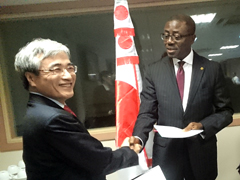
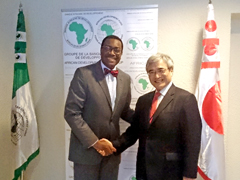
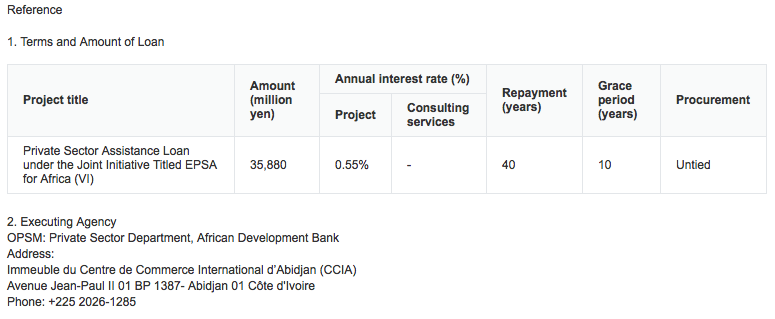
[Ministry of Foreign Affairs] [Tuesday, Sep 8, 2015]
Dispatch of Election Observer Mission and Assistance to Myanmar in Response to Flood Disaster
1. The Government of Japan decided to dispatch an election observer mission headed by Mr. Yohei Sasakawa, Special Envoy of the Government of Japan for National Reconciliation in Myanmar, for the general election to be held in the Republic of the Union of Myanmar on November 8. The Government of Japan hopes that the election will be carried out successfully and democratization of Myanmar will progress further. The Government of Japan will support a free and fair election through the dispatch of this election observer mission.
2. Moreover, a flood disaster triggered by heavy rain which started in mid-July has caused severe damage in Myanmar. For the rehabilitation and reconstruction of Myanmar, Japan will implement two grant aids totaling approximately JPY 4 billion to Myanmar. Separately, the Government of Japan will also swiftly proceed with additional necessary assistance of around JPY 5 billion on the basis of requests from the Myanmar side, such as the reconstruction of schools and provision of water purification vehicles and machinery for digging wells.
[Japan International Cooperation Agency] [Thursday, Sep 3, 2015]
Signing of Grant Agreement with Haiti
On September 2, 2015, the Japan International Cooperation Agency (JICA) signed a grant agreement (G/A) with the Government of the Republic of Haiti to provide grant aid of up to 3.672 billion yen for assistance to the Project for the Construction of Bridges of Croix-des-Missions and Route Neuve [1].
Due to the enormous amount of destruction caused by the 2010 earthquake that hit the Port-au-Prince metropolitan area, as well as long years of political instability in Haiti, basic infrastructure such as transportation networks still need major improvements in order to enable and promote regional and national economic development. Based on its experience from the earthquake, the Government of Haiti has established the promotion of decentralization of economic and administrative functions from the capital to other regions as policies in its Strategic Development Plan [2] (2012–2033).
This project will fortify trunk roads connecting the capital region with outlying regions, one of the priority issues of the transportation sector in the Haiti Strategic Development Plan. National Route 1 together with a group of bypasses in the area form a portion of the arterial system that ensures transportation access between the capital metropolitan area and the northern and central regions of the country, as well as providing access to the industrial districts and major cities in those areas. This project will replace the Croix-des-Missions Bridge in the commune of Tabarre in Port-au-Prince Arrondissement, and another bridge in the commune of Cité Soleil, also in Port-au-Prince Arrondissement.
This project is expected to contribute to the socio-economic development of Haiti, especially to the northern and central regions, by providing safer infrastructure and better access to other regions for its users.
1: le Projet de Construction des Ponts de la Croix-des-Missions et de la Route Neuve
2: Plan stratégique de développement d’Haïti
